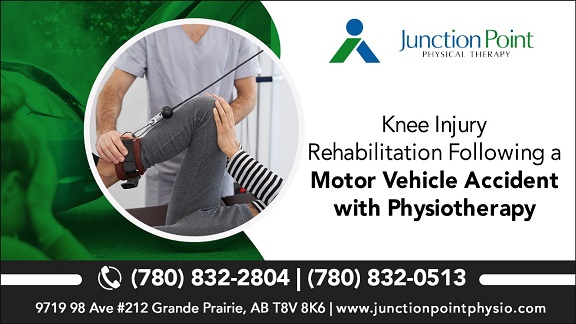
Motor Vehicle Accidents (MVAs) can leave more than just physical injuries—they can result in scar tissue formation that hinders movement and causes discomfort long after the accident. Scar tissue, also known as fibrosis, forms as the body heals after an injury, but it can often cause stiffness, pain, and limitations in mobility. Motor vehicle accidents Physiotherapy Grande Prairie At Junction Point Physical Therapy , one of the innovative treatment methods we offer to address scar tissue and improve healing after an MVA is the Graston Technique. This technique utilizes specialized tools to break down scar tissue and promote tissue healing, helping our patients regain function and reduce pain.
What is the Graston Technique?
The Graston Technique is an evidence-based manual therapy used by trained physiotherapists to treat soft tissue injuries and adhesions, especially those involving scar tissue. The technique involves the use of specially designed stainless-steel instruments that allow the therapist to detect and treat areas of fascial restriction and scar tissue. The tools are used to apply controlled, deep pressure to the affected areas, which helps in breaking down the dense tissue and promoting better circulation and healing.
The Graston Technique is effective in treating a range of musculoskeletal issues, including those resulting from motor vehicle accidents (MVAs), where scar tissue often forms in response to trauma. The method encourages the body’s natural healing response, helping restore mobility, function, and reduce pain.
How Does the Graston Technique Help with Scar Tissue from an MVA?
After an MVA, injury-related scar tissue can develop in muscles, tendons, ligaments, and fascia as part of the body’s healing process. While scar tissue is essential for closing wounds, it can sometimes form inappropriately, adhesions (areas where tissues stick together), stiffness, and chronic pain. This excess scar tissue can limit the normal function of muscles and joints, contributing to discomfort and difficulty moving.
The Graston Technique addresses these issues by:
Breaking Down Scar Tissue: The use of Graston tools helps break down fibrous tissue and adhesions that form during the healing process. This process makes it easier for the body to remodel the tissue into a more functional, flexible state.
Increasing Blood Flow: The technique stimulates blood flow to the affected area, which promotes the healing of the soft tissues. Improved circulation helps the tissues receive more oxygen and nutrients, which can accelerate the healing process.
Restoring Mobility and Function: By reducing adhesions and scar tissue formation, the Graston Technique helps improve range of motion and flexibility. This is particularly helpful for MVA patients who experience restricted movement in areas such as the neck, back, shoulders, and limbs.
Decreasing Pain: The process of breaking down scar tissue also helps reduce pain, especially the discomfort that is often associated with tight or restricted muscles and fascia.
When you visit Junction Point Physical Therapy in Grande Prairie for Graston Technique treatment, your physiotherapist will first assess the area of injury and determine the extent of scar tissue formation. The therapist will use the Graston tools to gently glide over the targeted area, applying controlled pressure to the soft tissues.
While the treatment can feel slightly intense, it is not typically painful. Most patients report a sensation of deep pressure or a mild discomfort, especially in areas where scar tissue is more prominent. The goal is to treat the scar tissue effectively without causing excessive pain or irritation.
In some cases, you may experience temporary redness, bruising, or soreness following the session, which is a normal response to the treatment.
Benefits of Graston Technique for MVA Scar Tissue Release
Faster Recovery: By effectively addressing scar tissue and promoting tissue regeneration, the Graston Technique can help accelerate the recovery process after an MVA.
Improved Range of Motion: Breaking down scar tissue allows for a wider range of motion, making it easier to move freely without stiffness or discomfort.
Long-Term Relief: Graston Technique helps not only in the short-term management of pain but also in the long-term resolution of issues caused by scar tissue. By promoting proper tissue healing, it reduces the likelihood of chronic pain and movement limitations in the future.
Non-Surgical Treatment: For many patients, the Graston Technique offers an effective alternative to surgery. It can address deep tissue injuries and adhesions without the need for invasive procedures.
Customized Treatment: At Junction Point Physical Therapy, our therapists tailor the Graston Technique treatment to meet your specific needs. Each patient’s case is unique, and our therapists work with you to ensure the treatment is appropriate and effective for your individual condition.
Conclusion
If you’ve experienced an MVA and are struggling with the effects of scar tissue—such as pain, stiffness, or limited movement—the Graston Technique may be the solution you need to restore your function and reduce discomfort. At Junction Point Physical Therapy in Grande Prairie, we offer this specialized treatment to help you heal effectively and regain your mobility. Our experienced physiotherapists will guide you through every step of the process, providing personalized care tailored to your recovery goals. If you’re ready to take the next step in your recovery, reach out to us today to schedule an appointment and learn more about how the Graston Technique can help you recover from MVA-related injuries.
#motorvehicleaccidentphysiotherapygrandeprairie #junctionpointphysicaltherapy #motorvehicleaccidentphysiotherapy #motorvehicleaccidentgrandeprairie #physiotherapynearme #physiotherapygrandeprairie #physicaltherapygrandeprairie
#physicaltherapynearme #physicaltherapy #caraccidentphysiotherapygrandeprairie